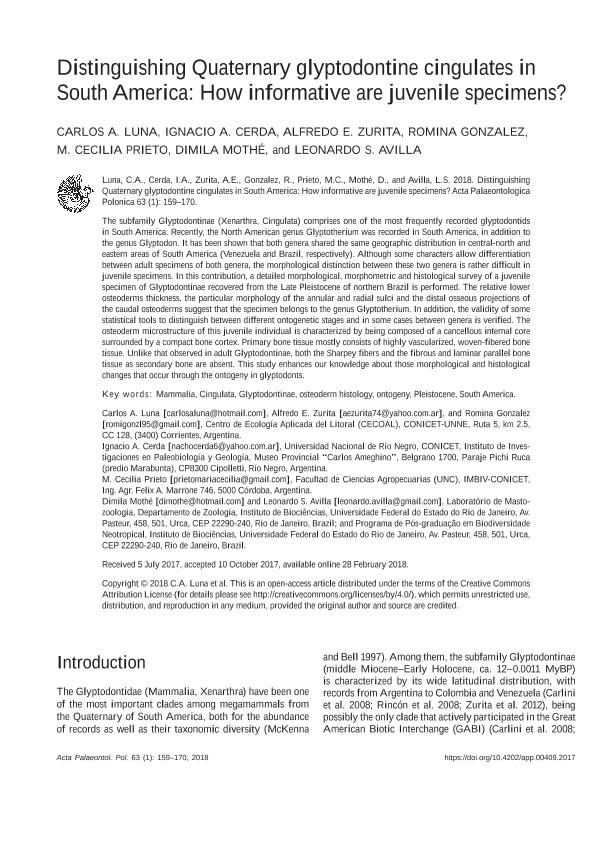Artículo
Distinguishing Quaternary glyptodontine cingulates in South America: How informative are juvenile specimens?
Luna, Carlos; Cerda, Ignacio Alejandro ; Zurita, Alfredo Eduardo
; Zurita, Alfredo Eduardo ; González, Romina
; González, Romina ; Prieto, María Cecilia
; Prieto, María Cecilia ; Mothé, Dimila; Avilla, Leonardo
; Mothé, Dimila; Avilla, Leonardo
 ; Zurita, Alfredo Eduardo
; Zurita, Alfredo Eduardo ; González, Romina
; González, Romina ; Prieto, María Cecilia
; Prieto, María Cecilia ; Mothé, Dimila; Avilla, Leonardo
; Mothé, Dimila; Avilla, Leonardo
Fecha de publicación:
03/2018
Editorial:
Polish Academy of Sciences. Institute of Paleobiology
Revista:
Acta Palaeontologica Polonica
ISSN:
0567-7920
e-ISSN:
1732-2421
Idioma:
Inglés
Tipo de recurso:
Artículo publicado
Clasificación temática:
Resumen
The subfamily Glyptodontinae (Xenarthra, Cingulata) comprises one of the most frequently recorded glyptodontids in South America. Recently, the North American genus Glyptotherium was recorded in South America, in addition to the genus Glyptodon. It has been shown that both genera shared the same geographic distribution in central-north and eastern areas of South America (Venezuela and Brazil, respectively). Although some characters allow differentiation between adult specimens of both genera, the morphological distinction between these two genera is rather difficult in juvenile specimens. In this contribution, a detailed morphological, morphometric and histological survey of a juvenile specimen of Glyptodontinae recovered from the Late Pleistocene of northern Brazil is performed. The relative lower osteoderms thickness, the particular morphology of the annular and radial sulci and the distal osseous projections of the caudal osteoderms suggest that the specimen belongs to the genus Glyptotherium. In addition, the validity of some statistical tools to distinguish between different ontogenetic stages and in some cases between genera is verified. The osteoderm microstructure of this juvenile individual is characterized by being composed of a cancellous internal coresurrounded by a compact bone cortex. Primary bone tissue mostly consists of highly vascularized, woven-fibered bone tissue. Unlike that observed in adult Glyptodontinae, both the Sharpey fibers and the fibrous and laminar parallel bone tissue as secondary bone are absent. This study enhances our knowledge about those morphological and histological changes that occur through the ontogeny in glyptodonts.
Palabras clave:
MAMMALIA
,
CINGULATA
,
OSTEODERM HISTOLOGY
,
SOUTH AMERICA
Archivos asociados
Licencia
Identificadores
Colecciones
Articulos(CECOAL)
Articulos de CENTRO DE ECOLOGIA APLICADA DEL LITORAL (I)
Articulos de CENTRO DE ECOLOGIA APLICADA DEL LITORAL (I)
Articulos(IIPG)
Articulos de INSTITUTO DE INVESTIGACION EN PALEOBIOLOGIA Y GEOLOGIA
Articulos de INSTITUTO DE INVESTIGACION EN PALEOBIOLOGIA Y GEOLOGIA
Articulos(IMBIV)
Articulos de INST.MULTIDISCIPL.DE BIOLOGIA VEGETAL (P)
Articulos de INST.MULTIDISCIPL.DE BIOLOGIA VEGETAL (P)
Citación
Luna, Carlos; Cerda, Ignacio Alejandro; Zurita, Alfredo Eduardo; González, Romina; Prieto, María Cecilia; et al.; Distinguishing Quaternary glyptodontine cingulates in South America: How informative are juvenile specimens?; Polish Academy of Sciences. Institute of Paleobiology; Acta Palaeontologica Polonica; 63; 1; 3-2018; 159-170
Compartir
Altmétricas



